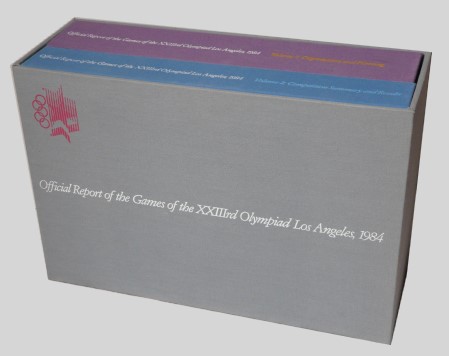Official reports 1984
As part of its agreement as host of the Games,
the LAOOC submitted an "Official Report" to the members of the IOC at its
regularly scheduled sessions. These reports provided the IOC with updates
on the status of the Organizing Committee's efforts. Generally, the reports
contained updates in the areas of: accreditation, Arts Festival, ceremonies,
customs, finance, facilities, government relations, housing, medical program,
press operations, protocol, public relations, security, staffing, ticketing,
transportation, village operations and youth programs. Distribution of
these official reports adhered to the following timeline:
Publication title
First Official Report
Interim Report
Second Official Report
Interim Report
Third Official Report
Fourth Official Report
Fifth Official Report
Final Official Report
Date
7/16/80
4/81
10/1/81
2/82
5/27/82
3/26/83
2/6/84
6/1/85
Total pages
29
28
85
36
78
151
64
1,586
The final "Official Report" was compiled by
a staff of some 15 editors and research writers along with a design director,
office manager, photo editor, production manager and six administrative
assistants. This staff gathered reports from each operating department
manager and conducted personal interviews to gather background material
before composing the chapters and sections of the report. Since the LAOOC
made a commitment to terminate nearly all full-time employees at or soon
after the conclusion of the Games, the "Official Report" staff was reassembled
from existing full-time staff to begin work in September 1984. With a 39-chapter
topic outline as its guide, the staff set out to produce their 1,586-page
document in two parts: Volume One/ Organization and Facilities and Volume
Two/Competitions. The brunt of the research and writing (in English) was
completed by 15 January 1985 with translation into French completed by
1 May 1985.
A highly-respected Los Angeles design firm
was awarded the contract to design and produce both volumes. In addition
to the principal, who was directly involved in the project, the firm also
utilized two project managers, three design coordinators, two production
coordinators and a half-dozen production artists. Site drawings and charts
were subcontracted to a local architectural graphics studio, which employed
a team of up to 10 delineators. Keyboarding of manuscript was done in-house
onto a micro-computer using word-processing software. The LAOOC transmitted
data via modem to a local computer typesetting company for immediate output
of final typeset text. This saved the time-consuming step of re-entering
final text and allowed for quicker editing and proof reading by the "Official
Report" editorial staff. The two-volume, hard-bound set was made available
for purchase to an exclusive list of Olympic sponsors, supporters, staff
members and ticket buyers, with a 31 January 1985 deadline for orders.
Price of the oversized publication was set at $485 plus handling, shipping
and applicable sales tax, bringing total cost to $550 in the United States
and $600 for deliveries to foreign countries. An anticipated press run
of 2,000 copies was revised accordingly based upon the number of sales
orders received. The report was presented to members of the International
Olympic Committee at its 90th Session (2-6 June 1985) in Berlin, German
Democratic Republic, just nine months after the project was begun. General
distribution to subscribers was completed by August 1985.
The "Official Report of the Games of the XXlllrd
Olympiad" is an extremely large project which also requires a dedicated
staff and a lengthy preparation period to produce a useful, lasting document.
For the best results in compiling a report of this magnitude, a research/writing
staff should be collected prior to the Games to finalize a table of contents
while planning information is still meaningful and available. By beginning
preparations for the "Official Report" early. heads of operating departments
can be told which records and documents to keep for future research and
publication. Given the time-sensitive demands placed on a very small staff,
the Publications Department far exceeded the minimum requirements of the
IOC and LAOOC and served the needs of their three principal clients: the
Olympic Family, the media and the general public. It also served the needs
of Olympic sponsors, suppliers and licensees. Overall, then, the publications
produced by the LAOOC were colorful, well designed, informative and fully
sufficient to meet the needs of those who received them. In the 18 months
prior to the Games, the Publications Department met the requirements of
operating departments whose own needs became apparent only a short time
before final products were needed.
(Source document: Official Report 1984, vol. I, page
576)

